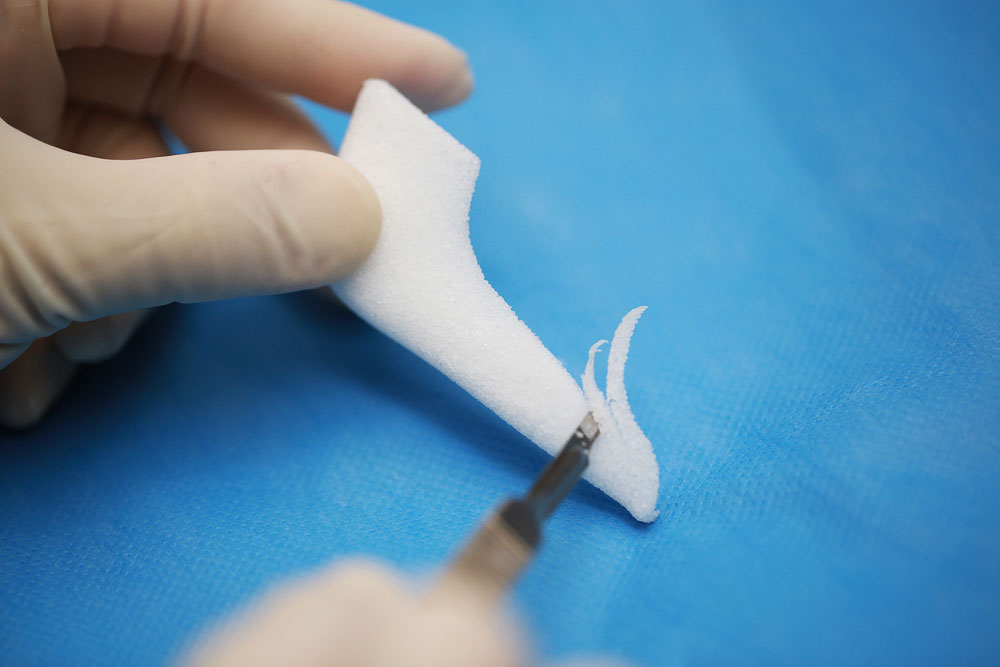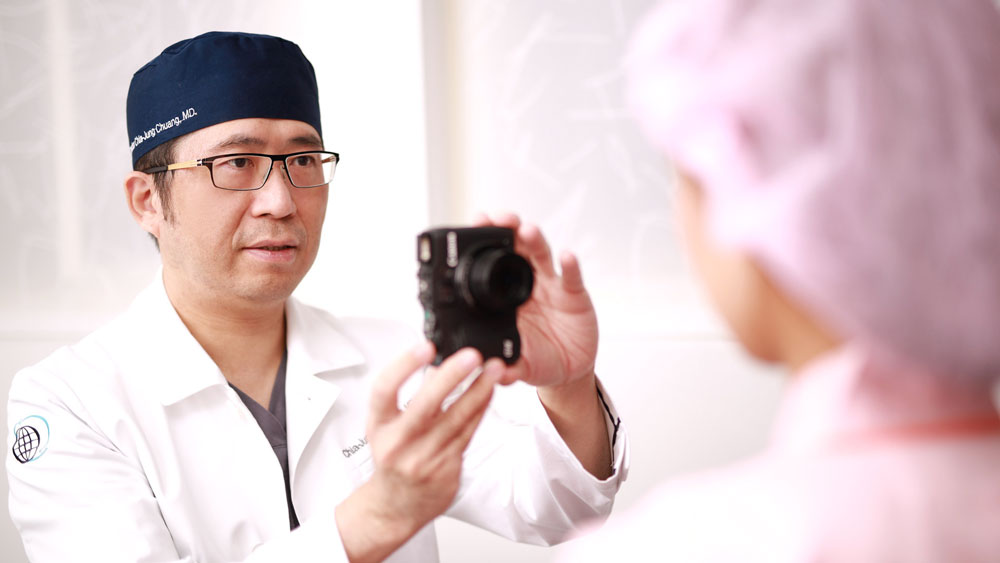Surgical Concept
The facial contour of the eyes, nose and lips is like a photo frame to a photo. However, properly arranging abundant contents in the limited frame and highlighting each characteristic challenges the physician’s esthetics and profession. Dr. Chuang has always considered that the congenital face skeleton is not a critical factor for facial organ surgeries but that reconstructing individualized features for patients with different face shapes or redressing congenital facial structural defects by numerous procedures constitutes the most valuable portion of facial plastic surgeries. Nevertheless, the eyes and nose are frequently the most important and frequently operated on parts in traditional facial organ plastic surgeries because their appearances contribute to over 50% of the facial beauty. However, Dr. Chuang considers that many other surgeries can also be performed to address or mend congenital facial organ and contour defects, such as surgery at the forehead, submalar triangle, chin, or lips, which will gradually play vital roles among the mainstream well-sculpted surgical options and non-negligible details for females desiring a perfect facial appearance.
Dr. Chuang has been dedicated to studies on plastic surgeries of various facial parts and regardless of forehead augmentation, chin surgeries, submalar triangle augmentation (apple cheek surgery), nasolabial groove reinforcement , or lip plasty and otoplasty, offers customized surgical suggestions and plans in light of patients’ facial contours and proportions individually to successfully set off the characteristics of the facial organs. Dr. Chuang upholds the following surgical concepts and principles of facial plastic surgeries:
Enhances side face balance and esthetics
Dr. Chuang has found that many patients always pursue a frontal change of the face but usually ignore the proportion and esthetics of the side face. According to well- proportionate facial profiles in females, the most attractive sites are the forehead, nose tip, and chin. The female forehead should be full and round, so if it appears flat, it can be corrected by autologous fat injection or forehead implant augmentation, and its profile should protrude further than submalar triangle vertical alignment. In Dr. Chuang’s surgical concept, if the forehead protrudes excessively further than the submalar triangle in the lateral profile, midface augmentation will be considered, while if the forehead retracts backward to the submalar triangle vertical line, forehead augmentation will be considered in contrast. Submalar triangle (midface augmentation) surgery not only improves the traditional oriental facial features of midface depression but also sculpts a 45° S-shaped curvature of the face and supports and plumps up the midface soft tissue to make patients present a charming expression with the midface lifted upward like a red apple (apple cheek augmentation). Meanwhile, it plays an essential role in balancing the forehead, nose, and chin. Moreover, the chin length and angle considerably influences the proportion of the face. In appearance, the chin should be slightly projected, sharp, and bony, with the profile prominence linear with the nose tip and upper (or lower) lip and chin line in a 45° angle with the jawbone. Patients with chin defects consider the emplacement of a chin prosthesis to improve the side face appearance or undergo set-back genioplasty if the chin is too long and protruded.
Replacement of soft tissue augmentation by prosthetic enhancement
The most frequently used methods to correct facial structural defects are nonsurgical hyaluronic acid injection or autologous fat grafting, but shortcomings such as poor durability and instability remain unconquerable obstacles, thus making patients hesitate in moving forward. Regarding the congenital deficiency of facial bone structures, such as at the midface depression or nasolabial groove, Dr. Chuang recommends facial implant augmentation in the replacement of a soft tissue filler injection to radically eradicate facial structural defects. The application of modern permanent prostheses such as Medpor or Chimera (Sili-Tex) diversifies traditional silicone implants to attain prolonged stable results. This surgery not only allows patients to obtain changes at multiple sites by one surgery but also prevents unexpected problems induced by a mini-invasive filler or fat injection such as temporary results or results short of expectation, skin deterioration caused by repeated injection, risks of infection due to multiple injections, and possible fat droopy tissues. Moreover, facial prosthesis surgery provides a radical option for patients who have spent a lot on filler injections but who have failed to attain ideal and permanent results.
Delays facial aging by emplacement of prosthesis
Facial aging does not merely lie in skin looseness or fat atrophy and more commonly arises from an unconscious loss of bone support, particularly at the cheekbone (midface deficiency) and jawbone, and is characterized by submalar triangle depression, a deeper nasolabial line, and chin retraction or withdrawal. Because such symptoms are difficult to be differentiated in the early stage, the physician needs to carefully inspect the patient’s skin and soft tissue conditions in a preoperative evaluation or results will be unobvious due to an improper management. Based on Dr. Chuang’s surgical experience, such structural problems need to be radically corrected at facial skeletal defects rather than by merely an injectable filling in the superficial skin or some other non-invasive procedures such as phototherapy, Thermage or Ultherapy . For patients with aging-induced facial bone atrophy or derivative collagen loss, Dr. Chuang recommends the emplacement of various facial prostheses to the submalar triangle or nasolabial depression to provide the fundamental support for soft tissue and skin. This surgery will also fill the volume of subcutaneous space to rapidly achieve plumpness and remedies the skeletal structure and prevents future rapid bone loss. Such a new surgical concept of using prostheses to tighten the skin not only provides natural and prolonged results but also enables patients to achieve skin rejuvenation without any filler injection or phototherapy, thus delaying future aging.
Dr. Chuang considers that facial plastic surgeries are aimed not only at rectifying patient’s individual cognitive defects but also in providing additional benefits. Therefore, the emplacement of facial prostheses, seemingly in a supporting role, presents stable results in anti-aging therapy if delicately and exquisitely conducted, and it can be conducted along with any facial plastic surgeries to achieve complete and consistent esthetic results.
Surgical characteristics
Emplacement of diverse prostheses
Facial prosthesis emplacement has long been conducted worldwide and has been mainly applied for repairing traumatic facial bone defects for a long time. As plastic surgery is gaining momentum, numerous facial prostheses are available in the market for using widely in esthetic purpose such as the augmentation of the forehead, cheekbone (submalar triangle), nasolabial fold (para-nasal depression), chin, or mandible to achieve permanent correction. Currently, such prostheses are available primarily in pure silicone, composite Sili-Tex (Chimera), and Medpor implants, but Dr. Chuang will make appropriate suggestions based on individual conditions and requirements. In recent years, with the advent of injectables, patients may avail themselves of mini-invasive filler injections to attain results similar to those obtained by facial prostheses, but the short-term effect, unstable absorption, and other risks such as skin necrosis make them unable in meeting the expectation of numerous patients. Due to its stability and durability, facial prosthesis emplacement still plays an irreplaceable role in facial plastic surgery. WiSH Clinic offers diversified materials, types, and sizes of facial prostheses to provide comprehensive options and customized results to patients.

Dr. Chuang will adjust and sculpt every facial implants to satisfy customized needs of patients.
Flexible application of multiple materials
Despite the fact that numerous prosthetic materials are used for the face, emplacing the prostheses into correctly recipient sites requires the ability to not only have a good knowledge of facial bones and soft tissues but also know the properties and indications of various materials to fully unleash the effects and value of concurrent surgeries. Dr. Chuang has over 10 years of experience in performing facial prosthesis plastic surgery and is certainly familiar with the applications of various surgical methods and materials and possible reactions or interactions between the emplaced prosthesis and the human body to reduce the occurrence of probable foreign body rejection or an incompatible reaction. Additionally, for common midface depression and nasolabial fold problems, Dr. Chuang recommends a silicone malar/sub-malar implant combined with a Medpor para-nasal implant for concurrent augmentation of the submalar triangle and nasolabial groove (also called “noble surgery” in Korea) to attain long-term stable results by the emplacement of a composite prosthesis. Regarding other facial defects due to congenital facial deformities (such as a long or crescent-shaped face), Dr. Chuang explains the difference between prosthesis emplacement and bone reduction to patients and lets them make the final decision to avoid unwanted or excessive correction.
Long-term stable results
The value of facial prosthesis emplacement lies in its prolonged and stable results and the less chance of drooping due to skin laxity or aging. Regardless of the ordinary silicone or highly physiologically compatible Medpor implants, prostheses have almost unchanging density and hardness and are therefore not decomposed and metabolized with time. Since the modern materials are less prone to result in rejection or interaction with human tissues, they are quite suitable for patients who wish to garner lifelong results in one surgery. Moreover, in recent years, we have refined the surgical methods of prosthesis emplacement, including the application of an LED head light system to emplace various prostheses via intraoral incisions to the subperiosteum (which allows the prosthesis to closely attach to the bone surface after the periosteum is detached) to prevent probable dislocation in the future. Dr. Chuang also applies titanium screws to fixate the Medpor prosthesis at the surgical site to ensure stable results, which provides a safer guarantee for such surgeries. Therefore, as long as the wound is taken good care of after the operation to avoid the infection or foreign body reaction of the prosthesis, patients generally enjoy the long-term stable results of facial plastic surgeries with great ease.
Composite facial reconstruction
Composite facial plastic surgery is based on the combined use of different surgeries and implant materials to fulfill facial reconstruction at one time. Frequently, facial bone reduction (bone contouring) and prosthesis emplacement (bone feature conversion or soft tissue augmentation) are integrated into one surgery to achieve multiple results. Moreover, holistic facial reconstruction entails prudent examinations, planning, and execution by a physician adept in various surgeries and with esthetic cultivation to let the seemingly complex but interlinked surgeries present coordinated and uniform esthetic results. Dr. Chuang has always held the view that facial plastic surgeries are indispensable and continuous and that if they are divided and conducted by different physicians, they not only heighten the risks of anesthesia and recovery from repeated surgeries but also predispose patients to differences and conflicts caused by the different esthetics of physicians, thus increasing the probability of future remolding or revision. To protect the patients of WiSH Clinic from such uncertain risks, Dr. Chuang independently performs various composite facial reconstructions and insists that one physician should perform the whole surgery to assume all responsibilities. No matter how long the surgery is, Dr. Chuang executes it all by himself, from the preoperative planning to the final wound stitching, so that patients can get rid of their old appearance under a safe and trustworthy ambience and enjoy the advantages and value brought about by composite facial plastic surgeries.

Dr. Chuang always takes a photograph in person for all patients before the surgery in order to precisely grasp the specific condition for each patient.
